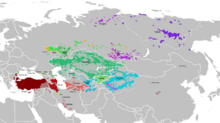Gelên tirkî
Gelên tirkî, komên etnîkî li Ewrasyayê ne ku zimanên tirkî yên cuda diaxivin.[19][20]
 | |
| Gelhe tevahî | |
|---|---|
| 170 mîlyon[1] | |
| Herêmên ku lê şêniyên sereke ne | |
| 61,142,000[2] | |
| 27,000,000[3] | |
| 13,000,000 - 18,000,000[4] | |
| 12,751,502[5] | |
| 12,300,000[6] | |
| 11,647,000[7] | |
| 8,177,691 - 8,600,000[8] | |
| 5,500,000[9] | |
| 4,600,000[10] | |
| 4,500,000[11] | |
| 4,233,600[12] | |
| 2,500,000[13] | |
| 1,000,000[13] | |
| 1,000,000[14] | |
| 500,000[15] | |
| 398,600[16] | |
| 313,626[17] | |
| 59,488[18] | |
| Ziman | |
| Zimanên tirkî | |
| Baweriya dînî | |
| Îslam (piranî), Xristiyanî, Cihûtî, Tengrîzm, Bê ol, û hinek din | |
| Têkildarên komên etnîkî | |
| Gelên îranî | |
Hin gelên tirkî yên îro ew in: altayî, azerî, gagawiz, qazax, qirgiz, tirkmen, tirk, tirkmenên iraqê, tirkên Kîprosê, tûvan, ûygûr, ûzbêk, qarayim, qirimçaq, teterên Krîmê, yaqût, xakas, çulîm, kumandî, şor, tofa, soyot.[21]
Çavkanî
biguhêre- ^ https://www.britannica.com/topic/Turkic-peoples
- ^ https://joshuaproject.net/people_groups/18274/tu
- ^ https://worldpopulationreview.com/countries/uzbekistan-population
- ^ https://minorityrights.org/minorities/azeris-2/
- ^ https://amp.theguardian.com/world/2015/dec/02/turks-in-russia-hit-by-putins-serious-consequences-after-downing-of-warplane
- ^ (bi inglîzî) "Kazakhstan". The World Factbook. Retrieved 21 December 2014. "Population: 17,948,816 (July 2014 est.)" "Ethnic groups: Kazakh (Qazaq) 63.1%, Russian 23.7%, Uzbek 2.9%, Ukrainian 2.1%, Uighur 1.4%, Tatar 1.3%, German 1.1%, other 4.4% (2009 est.)" Assuming Kazakh, Uzbek, Uighur and Tatar are included as Turks, 63.1% + 2.9% + 1.4% + 1.3% = 68.7%. 68.7% of 17.9m = 12.3m
- ^ http://www.stats.gov.cn/tjsj/ndsj/2021/indexeh.htm
- ^ https://www.cia.gov/the-world-factbook/countries/azerbaijan/
- ^ https://www.americanprogress.org/article/turkish-diaspora-europe/
- ^ https://minorityrights.org/minorities/uzbeks-and-turkmens/
- ^ https://www.cia.gov/the-world-factbook/countries/kyrgyzstan/
- ^ https://books.google.at/books?id=ib0wCwAAQBAJ&pg=PA241&redir_esc=y
- ^ a b https://web.archive.org/web/20161017222707/http://www.al-monitor.com/pulse/originals/2016/10/turkmens-iraq-mosul-tal-afar.html
- ^ "Kopîkirina arşîvê". Ji orîjînalê di 6 sibat 2023 de hat arşîvkirin. Roja gihiştinê 6 sibat 2023.
{{cite web}}: CS1 maint: archived copy as title (lînk) - ^ Nahost-Informationsdienst (ISSN 0949-1856): Presseausschnitte zu Politik, Wirtschaft und Gesellschaft in Nordafrika und dem Nahen und Mittleren Osten. Autors: Deutsches Orient–Institut; Deutsches Übersee–Institut. Hamburg: Deutsches Orient–Institut, 1996, seite 33.
- ^ http://2001.ukrcensus.gov.ua/eng/results/general/nationality/
- ^ https://web.archive.org/web/20160108225108/http://www.devplan.org/Ecosos/BOOK/SEG-2014.pdf
- ^ https://books.google.at/books?id=j42kCgAAQBAJ&pg=PT29&redir_esc=y
- ^ Encyclopedia Britannica. Turkic peoples. "Turkic peoples, any of various peoples whose members speak languages belonging to the Turkic subfamily..."
- ^ Yunusbayev et al. 2015, r. 1. "The Turkic peoples represent a diverse collection of ethnic groups defined by the Turkic languages."
- ^ Golden, Peter B. (25 tîrmeh 2018). "The Ethnogonic Tales of the Türks". The Medieval History Journal (bi îngilîzî). 21 (2): 291–327. doi:10.1177/0971945818775373. ISSN 0971-9458."Some DNA tests point to the Iranian connections of the Ashina and Ashide,133 highlighting further that the Turks as a whole ‘were made up of heterogeneous and somatically dissimilar populations’.134 Geographically, the accounts cover the regions of Inner Mongolia, Gansu, Xinjiang, the Yenisei zone and the Altay, regions with Turkic, Indo-European (Iranian [Saka] and Tokharian), Yeniseic, Uralic and other populations. Wusun elements, like most steppe polities of an ethno-linguistic mix, may have also played a substratal role."
| Ev gotara kurt şitlekê ye. Heke tu bixwazî berfireh bikî pê li biguhêre bike. (Çawa?) |